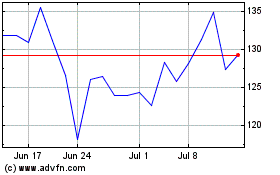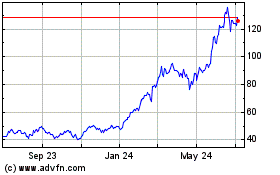Self-Drive Startup Uses Videogames to Improve Algorithms
December 05 2016 - 5:59AM
Dow Jones News
By Tim Higgins
When entrepreneur Laszlo Kishonti sought a faster way to program
his self-driving car to stay on the road, he turned to a
videogame.
The founder of the Budapest startup used a Microsoft Corp. Xbox
game console to engage the car's computer brain in a
hyper-realistic racing game. The gambit turned out to be a
breakthrough that helped the company speed up development of its
artificial intelligence-based driving technology.
The company, AImotive, which was formerly known AdasWorks, is
one of several teams racing to develop fully autonomous vehicles
that would replace human drivers with software. Mr. Kishonti, with
financial backing from auto-parts supplier Robert Bosch GmbH's
venture capital arm and chip maker Nvidia Corp., aims to have
software available for auto makers as soon as 2021, a deadline set
by several players including Ford Motor Co. and BMW AG. His company
employs more than 100 engineers and programmers, mostly in
Budapest.
Progress in building self-driving cars stems largely from
advances in software that allow computers to learn from experience.
As they drive, such cars collect data from cameras, sonar, radar
and other sensors that helps the computer improve. The greater the
variety of roads driven by these so-called machine-learning
systems, the better they can recognize roadway features, and the
better they can make decisions about how to respond to them.
"Our AI, and all of the AI in the world, learns from the
different scenarios," Mr. Kishonti said in an interview. He
previously founded a company specializing in performance
benchmarking software for high-performance graphics and computing.
"If you show them the same thing every time, it doesn't
improve."
Alphabet Inc.'s Google, for example, has accumulated huge
amounts of data from its 2 million miles of driving on public
roads, and uses the experiences to create countless variations in a
simulation to take the computer through what could happen on the
road.
It is a time-consuming process, and increasingly researchers
have wondered whether hyper-realistic videogames could substitute
for real-world roadways, saving developers time and money. That is
what Mr. Kishonti was hoping when he tried it early this year.
Other autonomous-driving researchers also have experimented with
imagery from videogames. Researchers at Intel Labs and Germany's
Darmstadt University of Technology published a paper detailing
their use of data from Take-Two Interactive Software Inc.'s Grand
Theft Auto videogame to teach a computer vision system to classify
objects along the road. Their idea: help the driving system
distinguish between cars and pedestrians.
"Although games can provide a virtually infinite amount of
photo-realistic training data, a limiting factor is the variety of
scenes in the game," said Stephan Richter, a Darmstadt visual
inference researcher. Grand Theft Auto V "is set in a city similar
to Los Angeles, so extracting data from GTA V will help your
algorithm to learn how driving in a Californian city may look like.
But transferring that knowledge to cities in Europe or Asia can be
tricky."
AImotive took a similar route, using a driving game -- the
company declined to reveal which one -- to help a car understand
how to behave on the road. Think of it as the first week of
driver's ed, but instead of practicing in an empty parking lot, the
system tried to keep the vehicle between the lines on a
computer-generated racetrack -- a lesson applicable to real-world
roadways.
Repetition is key. The team let the car's brain drive through
the videogame until it made a mistake, such as going off the road,
then restarted the game and tried again.
"One of the ways...to train AI [is] you just keep repeating
training steps and eventually get a little further and further" in
learning, said Niko Eiden, AImotive's chief operating officer.
Mr. Eiden described using the videogame to training a car to
steer, accelerate and brake. "Initially the car will always hit the
wall, but after a couple of million tries -- that take only a few
minutes on a regular PC -- it has learned by itself how to drive
around a random track and even accelerates on straight sections --
just like a child learns to walk!"
Mr. Kishonti said after using the videogame for a few weeks his
system had experienced all the variations to be found in the game
world. So the team collected high-definition video of real-world
driving and used the imagery to create videogame-like
simulations.
"We very quickly realized the advantages this kind of a setup
brings and therefore started to develop our own simulator, which we
can properly control and integrate into our development
environment," Mr. Eiden said. "Thanks to our own early experiments,
we now know ourselves exactly what we need and how to use a
simulator to ensure a safer autonomous driving experience in the
future."
Write to Tim Higgins at Tim.Higgins@WSJ.com
(END) Dow Jones Newswires
December 05, 2016 05:44 ET (10:44 GMT)
Copyright (c) 2016 Dow Jones & Company, Inc.
NVIDIA (NASDAQ:NVDA)
Historical Stock Chart
From Mar 2024 to Apr 2024

NVIDIA (NASDAQ:NVDA)
Historical Stock Chart
From Apr 2023 to Apr 2024
